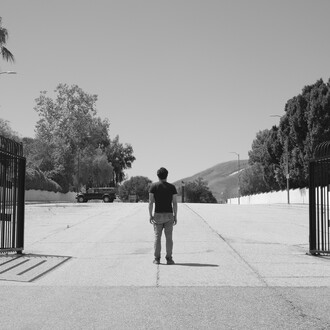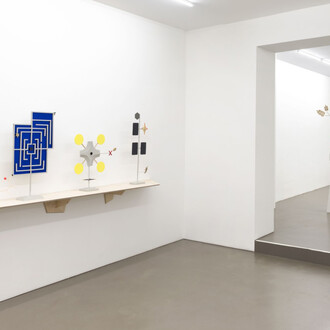A core concern of French-Swiss artist Julian Charrière is how human beings inhabit the world and how the world, in turn, inhabits us. The comprehensive solo exhibition at Museum Tinguely presents photographs, sculptures, installations and new video works that deal with our relationship to Earth as a world of water—a liquidity that covers most of our planet with seas, lakes and ice, both habitat for a myriad of organisms and host to circulatory systems critical for the stability of our climate. Unfolding over three floors, the exhibition Midnight zone engages with underwater ecologies, from the influential local presence of the Rhine to distant oceans, exploring the complexity of water as an elemental medium affected by anthropogenic degradation. Reflecting upon its flow and materiality, profundity and politics, its mundane and sacral dimensions, the solo show acts as a kaleidoscope, inviting us to dive deep.
In Midnight zone, Julian Charrière invites visitors to think and feel with water: as atmosphere, memory, movement and kin. Drifting between deep-sea descent and cryospheric suspension, the exhibition unfolds as an immersive reflection on fluid worlds—not the sea as surface, but as substance, where boundaries dissolve.
The artist considers this not only as a space to be entered, but as a world we can sink into and move within—becoming porous to its pressures, its depths, its dreams.
Midnight zone brings together a series of elemental investigations—earlier works alongside major new commissions that trace Charrière’s long-standing exploration of environmental thresholds. Unfolding over three floors, the exhibition’s focus is on water not as a motif, but as a medium: the material through which histories sediment, crises unfold, and forms change state. The title refers to the bathypelagic zone of the ocean, where sunlight vanishes and vision fades.
In the eponymous film Midnight zone (2025), a lighthouse Fresnel lens—a device meant to guide from a distance—is inverted and lowered into the abyss. Shot using a remotely operated deep-sea vehicle, the descent is both literal and metaphysical: a journey into a space that resists orientation, where polymetallic nodules—objects of industrial desire—rest amid ancient ecologies. Light here does not reveal; it fractures. The work hovers between dreams, illuminating the blind spots in our pursuit of progress.
In Albedo (2025), filmed beneath the arctic ocean between icebergs, the gaze shifts again. This time, the viewer follows water as it slips between solid, liquid, and vapor—a choreography of phase change unfolds in real time. Rather than rendering melting as catastrophe, the film resists the sublime, offering a study in flux, in atmospheres and absences. It reveals the sea as a kind of thought: unbounded, destabilizing and impossible to contain. The camera floats, reframes, releases. There are no fixed perspectives—only drift, suspension, dispersal.
These two film works anchor the exhibition that unfolds like a hydrological system—moving between material states, spatial logics and emotional registers. Set against the backdrop of Basel and its riverine histories, Midnight zone is attuned to the political and infrastructural presence of water. As a link between glaciers and oceans, the Rhine runs quietly beneath the museum—both a vector of trade and a climate-sensitive vein.
Sound, too, moves like a current throughout the exhibition—subtle, immersive and subaqueous—shaping a synesthetic experience that invites the visitor not only to look, but to listen, to feel, and to attune to another mode of sensing: one closer to being at rest, suspended, as if underwater.
Spanning film, sculpture, photography and installation, Charrière’s multidisciplinary practice is marked by immersive projects grounded in fieldwork within ecologically and symbolically charged sites—glaciers, volcanoes, nuclear test zones and deep-sea ecosystems. Through these intimate encounters with fragile environments, he explores how human activity inscribes itself into the fabric of the planet, subtly altering its surfaces, atmospheres and futures.
Fusing scientific observation with speculative poetics, his works foreground landscapes as physical processes, repositories of memory and vessels of cultural imagination. Rather than illustrating environmental crises directly, Charrière creates spaces where wonder and disquiet coexist, allowing viewers to experience the contradictions and tensions of our contemporary condition. His practice probes the colonial and extractivist legacies embedded within acts of exploration, landscape representation and the technologies of seeing.
In the exhibition, the artist’s works aim to offer a sensuous mode of knowing, of dwelling within the liquid conditions of our planet. Here, water is not considered as a stage for human drama but as a protagonist. It is regarded as an archive, mirror, solvent and signal that holds the memory of glaciers and the minerals of tomorrow. He wants to show how it binds our breath to the biosphere and reveals the fragility of a world shaped by evaporation, melt and sedimentation.
The show reminds us that the ocean is not the opposite of land, but its precondition. Humankind is suspended in its flows—biologically, historically and imaginatively.
A particular quality of Julian Charrière’s work is the way it translates artistic research into visual worlds that give sensory access to complex issues. In our exhibition, it is the ‘oceanic feeling’ that allows us to immerse ourselves visually and physically, while also setting in motion an engagement with urgent ecological questions of our time.
(Roland Wetzel)
Although the ocean comprises 95% of Earth’s habitable volume, we continue to live as if the planet ends at the shoreline. My work begins from this dissonance—between the scale of the sea and the limits of our cultural imagination. Science can map and measure the deep, but it cannot make us feel it. What we need is not only knowledge, but a culture of proximity: one that binds us emotionally and imaginatively to this vast, vital realm. Art, I believe, can serve as a tether—inviting us to inhabit the deep not as an abstraction or resource, but as a living space on which our own survival intimately depends.
(Julian Charrière)
In the works shown in Basel, Charrière does not want to show us the sea. He intends to let it speak, pulse and breathe through image, sound and elemental choreography. The result is not representation but resonance: a state of atmospheric intimacy, an invitation to see through its currents.
















